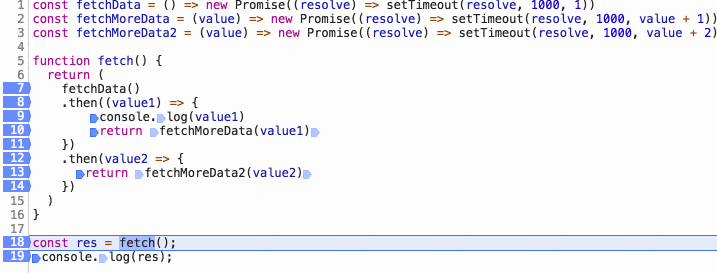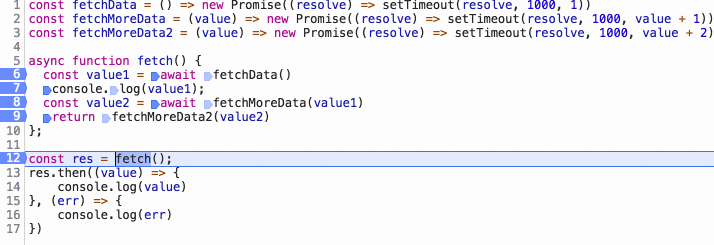이 기사는 ES6의 Async 기능에 대한 자세한 소개를 제공합니다(예제 포함). 도움이 필요한 친구들이 참고할 수 있기를 바랍니다.
ES2017 표준에는 비동기 기능이 도입되어 비동기 작업이 더욱 편리해졌습니다.
비동기 처리 측면에서 비동기 함수는 생성기 함수의 구문 설탕입니다.
예:
// 使用 generator
var fetch = require('node-fetch');
var co = require('co');
function* gen() {
var r1 = yield fetch('https://api.github.com/users/github');
var json1 = yield r1.json();
console.log(json1.bio);
}
co(gen);async를 사용할 때:
// 使用 async
var fetch = require('node-fetch');
var fetchData = async function () {
var r1 = await fetch('https://api.github.com/users/github');
var json1 = await r1.json();
console.log(json1.bio);
};
fetchData();실제로 비동기 함수의 구현 원리는 Generator 함수와 자동 실행기를 함수로 래핑하는 것입니다.
async function fn(args) {
// ...
}
// 等同于
function fn(args) {
return spawn(function* () {
// ...
});
}spawn 함수는 co와 같은 자동 실행기를 말합니다.
또한 async 함수는 Promise 객체를 반환하므로 async 함수는 Promise와 Generator를 기반으로 한 캡슐화 계층이라는 것도 이해할 수 있습니다.
엄밀히 말하면 async는 구문이고 Promise는 내장 개체입니다. async 함수도 Promise 개체를 반환한다는 점은 말할 것도 없고...
여기에서는 주로 보여줍니다. 일부 시나리오에서는 async를 사용하면 Promise를 사용하는 것보다 비동기 프로세스를 더 우아하게 처리할 수 있습니다.
/**
* 示例一
*/
function fetch() {
return (
fetchData()
.then(() => {
return "done"
});
)
}
async function fetch() {
await fetchData()
return "done"
};/**
* 示例二
*/
function fetch() {
return fetchData()
.then(data => {
if (data.moreData) {
return fetchAnotherData(data)
.then(moreData => {
return moreData
})
} else {
return data
}
});
}
async function fetch() {
const data = await fetchData()
if (data.moreData) {
const moreData = await fetchAnotherData(data);
return moreData
} else {
return data
}
};/**
* 示例三
*/
function fetch() {
return (
fetchData()
.then(value1 => {
return fetchMoreData(value1)
})
.then(value2 => {
return fetchMoreData2(value2)
})
)
}
async function fetch() {
const value1 = await fetchData()
const value2 = await fetchMoreData(value1)
return fetchMoreData2(value2)
};function fetch() {
try {
fetchData()
.then(result => {
const data = JSON.parse(result)
})
.catch((err) => {
console.log(err)
})
} catch (err) {
console.log(err)
}
}이 코드에서 try/catch는 fetchData()에서 일부 Promise 생성 오류를 포착할 수 있지만, JSON.parse에서 발생하는 예외는 포착할 수 없습니다. JSON.parse에서 발생한 예외를 처리하려면 예외 처리 논리를 반복하는 catch 함수를 추가해야 합니다.
실제 프로젝트에서는 오류 처리 논리가 복잡하여 코드가 중복될 수 있습니다.
async function fetch() {
try {
const data = JSON.parse(await fetchData())
} catch (err) {
console.log(err)
}
};async/await의 출현으로 try/catch를 통해 동기 및 비동기 오류를 캡처할 수 있습니다.
const fetchData = () => new Promise((resolve) => setTimeout(resolve, 1000, 1))
const fetchMoreData = (value) => new Promise((resolve) => setTimeout(resolve, 1000, value + 1))
const fetchMoreData2 = (value) => new Promise((resolve) => setTimeout(resolve, 1000, value + 2))
function fetch() {
return (
fetchData()
.then((value1) => {
console.log(value1)
return fetchMoreData(value1)
})
.then(value2 => {
return fetchMoreData2(value2)
})
)
}
const res = fetch();
console.log(res);
then의 코드는 비동기적으로 실행되기 때문에 포인트를 중단하면 코드가 순차적으로 실행되지 않으며, 특히 step over를 사용할 경우 then 함수가 직접 실행됩니다. 다음 then 함수를 입력하세요.
const fetchData = () => new Promise((resolve) => setTimeout(resolve, 1000, 1))
const fetchMoreData = () => new Promise((resolve) => setTimeout(resolve, 1000, 2))
const fetchMoreData2 = () => new Promise((resolve) => setTimeout(resolve, 1000, 3))
async function fetch() {
const value1 = await fetchData()
const value2 = await fetchMoreData(value1)
return fetchMoreData2(value2)
};
const res = fetch();
console.log(res);
비동기를 사용하면 동기 코드를 디버깅하는 것처럼 디버깅할 수 있습니다.
async hell은 주로 개발자들이 문법적 단순함을 탐하고 병렬로 실행할 수 있는 내용을 순차적 실행으로 전환하여 성능에 영향을 미치는 것을 일컫는 말인데, 지옥이라고 표현하는 것은 좀 과장된 표현입니다...
For 예:
(async () => {
const getList = await getList();
const getAnotherList = await getAnotherList();
})();getList() 및 getAnotherList()는 실제로 종속성이 없지만 현재 작성 방법은 간단하지만 getList()가 반환된 후에만 getAnotherList()가 실행되도록 하여 요청 시간이 두 배가 됩니다.
이 문제를 해결하기 위해 다음과 같이 변경할 수 있습니다:
(async () => {
const listPromise = getList();
const anotherListPromise = getAnotherList();
await listPromise;
await anotherListPromise;
})();Promise.all()을 사용할 수도 있습니다:
(async () => {
Promise.all([getList(), getAnotherList()]).then(...);
})();물론 위의 예는 비교적 간단하므로 다시 확장해 보겠습니다.
(async () => {
const listPromise = await getList();
const anotherListPromise = await getAnotherList();
// do something
await submit(listData);
await submit(anotherListData);
})();await 기능으로 인해 전체 예제에는 명확한 순서가 있지만 getList() 및 getAnotherList()는 실제로 종속성이 없으며 submit(listData) 및 submit(anotherListData)에는 종속성이 없으므로 이 예제를 어떻게 다시 작성해야 합니까? ?
기본적으로 세 단계로 나뉩니다.
1. 종속성을 확인합니다.
여기서 submit(listData)는 getList() 뒤에 와야 하고 submit(anotherListData)는 anotherListPromise() 뒤에 와야 합니다.
2. 비동기 함수에 상호 의존적인 명령문을 래핑합니다
async function handleList() {
const listPromise = await getList();
// ...
await submit(listData);
}
async function handleAnotherList() {
const anotherListPromise = await getAnotherList()
// ...
await submit(anotherListData)
}3. 비동기 함수를 동시에 실행합니다
async function handleList() {
const listPromise = await getList();
// ...
await submit(listData);
}
async function handleAnotherList() {
const anotherListPromise = await getAnotherList()
// ...
await submit(anotherListData)
}
// 方法一
(async () => {
const handleListPromise = handleList()
const handleAnotherListPromise = handleAnotherList()
await handleListPromise
await handleAnotherListPromise
})()
// 方法二
(async () => {
Promise.all([handleList(), handleAnotherList()]).then()
})()질문: URL 배열이 주어지면 인터페이스 계승을 구현하는 방법 개발 및 동시성이 있습니까?
async 후속 구현:
// 继发一
async function loadData() {
var res1 = await fetch(url1);
var res2 = await fetch(url2);
var res3 = await fetch(url3);
return "whew all done";
}// 继发二
async function loadData(urls) {
for (const url of urls) {
const response = await fetch(url);
console.log(await response.text());
}
}async 동시 구현:
// 并发一
async function loadData() {
var res = await Promise.all([fetch(url1), fetch(url2), fetch(url3)]);
return "whew all done";
}// 并发二
async function loadData(urls) {
// 并发读取 url
const textPromises = urls.map(async url => {
const response = await fetch(url);
return response.text();
});
// 按次序输出
for (const textPromise of textPromises) {
console.log(await textPromise);
}
}try catch를 사용하여 오류를 캡처할 수 있지만 여러 오류를 캡처하고 다른 처리를 수행해야 할 경우 빠르게 catch를 시도하면 다음과 같은 결과가 발생합니다. 복잡한 코드(예:
async function asyncTask(cb) {
try {
const user = await UserModel.findById(1);
if(!user) return cb('No user found');
} catch(e) {
return cb('Unexpected error occurred');
}
try {
const savedTask = await TaskModel({userId: user.id, name: 'Demo Task'});
} catch(e) {
return cb('Error occurred while saving task');
}
if(user.notificationsEnabled) {
try {
await NotificationService.sendNotification(user.id, 'Task Created');
} catch(e) {
return cb('Error while sending notification');
}
}
if(savedTask.assignedUser.id !== user.id) {
try {
await NotificationService.sendNotification(savedTask.assignedUser.id, 'Task was created for you');
} catch(e) {
return cb('Error while sending notification');
}
}
cb(null, savedTask);
}) 이 오류 캡처를 단순화하려면 Wait 후에 promise 개체에 catch 함수를 추가할 수 있습니다.
// to.js
export default function to(promise) {
return promise.then(data => {
return [null, data];
})
.catch(err => [err]);
}전체 오류 캡처 코드는 다음과 같습니다. 단순화:
import to from './to.js';
async function asyncTask() {
let err, user, savedTask;
[err, user] = await to(UserModel.findById(1));
if(!user) throw new CustomerError('No user found');
[err, savedTask] = await to(TaskModel({userId: user.id, name: 'Demo Task'}));
if(err) throw new CustomError('Error occurred while saving task');
if(user.notificationsEnabled) {
const [err] = await to(NotificationService.sendNotification(user.id, 'Task Created'));
if (err) console.error('Just log the error and continue flow');
}
}Generator는 원래 생성기로 사용됩니다. 비동기식 요청을 처리하기 위해 Generator를 사용하는 것은 단지 해킹된 사용법일 뿐입니다. 비동기화는 Generator를 대체할 수 있지만 async 및 Generator 자체의 두 가지 구문은 서로 다른 문제를 해결하는 데 사용됩니다.
async 함수는 Promise 객체를 반환합니다
복잡한 비동기 프로세스에 직면하면 Promise가 제공하는 all과 race가 더 유용할 것입니다
Promise 자체가 객체이므로 코드에서 임의로 전달할 수 있습니다.
Async 지원률은 아직 매우 낮습니다. Babel을 사용하더라도 컴파일 후에 약 1000줄이 추가됩니다.
위 내용은 ES6의 비동기 기능에 대한 자세한 소개(예제 포함)의 상세 내용입니다. 자세한 내용은 PHP 중국어 웹사이트의 기타 관련 기사를 참조하세요!